Archive for October, 2009
Monday, October 26th, 2009
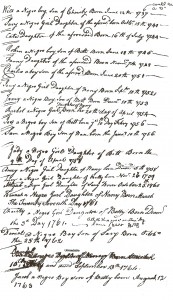
Blow Family Bible
Slave owners kept detailed records of their slaves’ births, and deaths, and purchases; although many of them have not survived. They often recorded these events in their family bibles along with information on their own families.
The 1715 Blow family bible records the births of slaves owned by the Blows of Sussex, and Southampton counties in Virginia. Nineteen births of four mothers are recorded from 1737 to 1763 spanning three generations. This is a goldmine of information for African American research. Descendants of these slaves can be found searching other records in the Blow Family Papers in the Swem Library in Virginia.
Tags:African American History, African American Names, African Slaves, Black Genealogy, Blow Family, Blow Family Bible, family history, family research, Genealogy & DNA, George Blow, Michael Blow, plantation slavery, Richard Blow, Samuel Blow, Slave Bill of Sale, Slave Name Patterns, Slave Names, Slave Records, slave trade, Southampton County Virginia, Sussex County Virginia, Swem Library, Tower Hill Plantation, Transatlantic Slave Trade, Virginia Plantation, Virginia Slavery
Posted in Civil War, Genealogy & DNA, Interviews, Introduction & Personal, Plantation Life, Research | Comments Closed
Friday, October 23rd, 2009
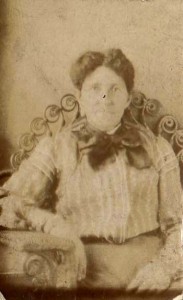
Arry Fort Pitt 1836-1918
Today divorce is very common, but in 1800s and early 1900s it was rarely heard of, especially among African Americans. In my research I found this extraordinary divorce case of two former slaves in Robertson County, Tennessee which detailed the history of their family.
Alford Pitt 1830-1900 and his wife Arry Fort Pitt 1836-1918 were married during slavery and had eleven children. Alford was a carpenter and later accumulated more than 500 acres of land. He had African American and white sharecroppers working his land.
In 1900, Arry filed for divorce from Alford stating that he had an affair with two black women and one white one. She stated that she had worked hard to help him amass everything they owned and she was entitled to half. Alford claimed that she had not helped him accumulate his wealth and felt since they married during slavery and never married after they were emancipated that she was not legally his wife and therefore not entitled to any of his property.
The divorce case put a great strain on the Pitt family, their friends and neighbors. Arry had more than fifty witnesses to prove her claims and Alford had nearly as many to support his. Half the children sided with their mother and the others their father.
Arry was represented in court by a family member of her former owners. In 1866, a law was passed in Tennessee which made all former slave marriages legal if the couple continued to live as man and wife.
The courts ordered Alford to give Arry 100 acres of land, $1,000, a horse and buggy and other livestock. Shortly after the verdict Alford died from complications of a cold that he caught from walking to court in bad weather.
Some of the Pitt property is still owned by their direct descendants. A street that runs through the property bears the family name.
Tags:African American Genealogy, African American History, Black Landowners, Divorce, Divorce Cases, Emancipation, family history, family research, Freedmen, Freedmens Bank, Freedmens Bureau, Genealogy & DNA, Oral History, Pitt Family, Slave Family, Slave Marriage, Slavery
Posted in Genealogy & DNA, Interviews, Introduction & Personal, Plantation Life, Research | Comments Closed
Tuesday, October 20th, 2009
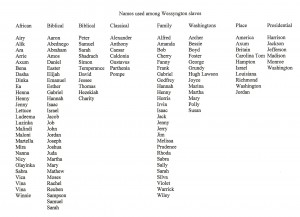
Names Among Wessyngton Slaves
African Americans got their given or first names from various sources during the slavery. Some of them used African “day names” such as Cudjo, Mingo, and Cuffee, denoting the day of the week on which they were born. Others used names from the Bible, classical names, place names, names of plantation owner’s families, famous individuals like the presidents and their own family members.
The document above lists various sources of names of individuals enslaved on Wessyngton Plantation from 1796 to 1865.
Tags:African American History, African American Names, African American slavery, African Names, Biblical Names, Day Names, Naming Practices, Slave Names
Posted in Civil War, Genealogy & DNA, Interviews, Plantation Life, Research | Comments Closed
Sunday, October 18th, 2009
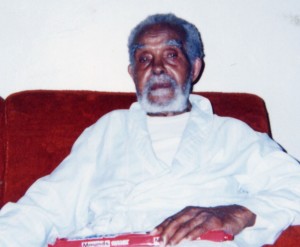
Joseph Washington 1895-2002
In more than thirty years of researching my ancestry and the lives of African Americans enslaved on Wessyngton Plantation, I have had the honor of interviewing more than twenty individuals whose parents or grandparents lived on the plantation. These individuals ranged in age from eighty to 107 years old.
Although I found hundreds of documents about my ancestors from plantation records written by the owners of Wessyngton, I learned many personal things about my ancestors from conducting interviews with elder family members.
In 1994, I visited my cousin Joseph Washington 1895-2002 (pictured above) at his home in Mansfield, Ohio on his one hundred second birthday. As a child Joseph lived next door to my great-great-grandparents Emanuel and Henny Washington who were born at Wessyngton in the early 1800s. He related many stories about them to me including ghost stories that my great-great-grandfather used to tell all the children on the plantation and songs he used to sing. Joseph told me what life was like on the plantation when he grew up there and how many people on the plantation were related to one another.
Oral history is a vital key to tracing African American genealogy and provides many details about our ancestors that can’t be found in records.
Tags:African American History, African American Oral History, African American slavery, Black Genealogy, black history, Civil War, family history, Griot, Interviews, Joseph Washington, Oral History, Oral Tradition, plantation slavery, Plantations, Tennessee history, Tennessee slavery
Posted in Civil War, Current Events, Interviews, Plantation Life, Research | Comments Closed
Saturday, October 17th, 2009
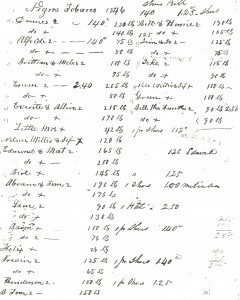
Slaves' Tobacco on Wessyngton Plantation 1846
Enslaved African Americans on Wessyngton Plantation worked under a task system. The plantation owner assigned a task to each individual. Once the task was completed the slave was free to work on his own crops of tobacco if he chose to do so. The owner usually assigned tasks that would take the entire day to complete. However, some of the fastest workers were able to complete the assigned tasks and work for themselves. The slaves were not required to work on Sunday and were off half days on Saturdays. Many of the slaves used this time to cultivate their own crops. The task system required less supervision by overseers than gang labor and gave slaves more control of their time.
The owner kept a list of how much tobacco each person raised and paid them after the crops were sold in New Orleans. The slaves used the money from the sale of the crops to purchase various items not provided by the plantation owner. The document above lists the names of men on Wessyngton Plantation in 1846 who raised their own crops and the items they purchased for their families.
Tags:Add new tag, Field Hands, Gang Labor, Overseer, Plantation Owner, Plantation Production, plantation slavery, Plantation Slaves, runaway slaves, Slave Life, Southern Plantations, Task System, Tobacco Production, Work Songs
Posted in Civil War, Genealogy & DNA, Interviews, Introduction & Personal, Plantation Life, Research | Comments Closed
Wednesday, October 14th, 2009
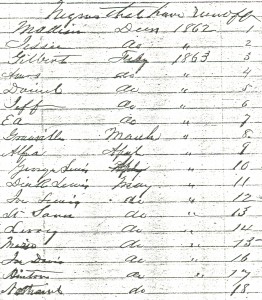
Runaway Slaves from Wessyngton Plantation 1862-1863
President Lincoln’s Emancipation Proclamation, issued September 22, 1862, declared freedom to slaves in the confederate states that did not return to the control of the Union by January 1, 1863. It did not free slaves from the border states Kentucky, Maryland, Missouri, and Tennessee. Many slaves from these states, however, were already free by this time due to self-emancipation─running away or being abandoned by their owners.
George A. Washington realized that his slaves would soon be tempted to leave his plantation Wessyngton. At the same time the Union Army was recruiting black soldiers, George made an offer to hire some of his slaves for a rate of $10 per month. From February through May 1863, twenty-four men agreed to stay on the plantation and work for the offered $10 per month. Of those twenty-four, however; eighteen left within a few months. The men had worked on the plantation all their lives and no doubt wanted to see what the outside world had to offer and to taste freedom. The men must have seen the offered salary as an attempt to keep them on the plantation. The above document lists the eighteen individuals who ran away from Wessyngton Plantation from 1862-1863.
Tags:Abraham Lincoln, Civil War, Confederate Army, Contraband, Contraband Camps, Emancipation, Emancipation Proclamation, plantation slavery, President Lincoln, runaway slaves, Union Army
Posted in Civil War, Interviews, Introduction & Personal, Plantation Life, Research | Comments Closed
Monday, October 12th, 2009
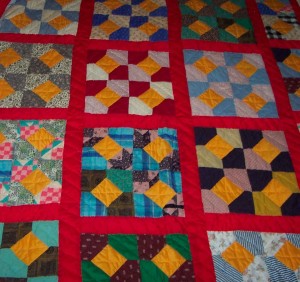
Hand-Stitched Quilt by Maggie Washington
So many of us have quilts or other crafts made by our ancestors. Hopefully we all display them carefully in our homes. But these pieces have stories that need to be preserved as well. This quilt was sewn by my great-aunt Maggie Washington. She made it for me as a birthday gift when she was in her nineties. Aunt Mag learned to make quilts from her mother when she was a small girl and often gave these special gifts to family members and friends on specials occasions such birthdays, weddings and Christmas.
Tags:Arts, Crafts, Maggie Washington, Quilt making, Quilting, Quilts, Sewing, Weaving
Posted in Genealogy & DNA, Interviews, Introduction & Personal, Research | Comments Closed
Sunday, October 11th, 2009
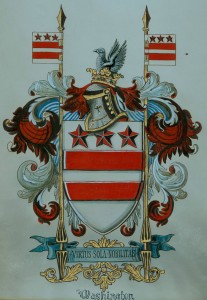
Washington Family Crest
The Washingtons trace their ancestry back to William de Hertburn in twelfth-century England where their family owned a manor estate called Wessyngton─the Norman spelling of Washington. William de Hertburn changed his name to William de Wessyngton. The first Washington to come to America in Joseph Washington’s line was John Washington, who immigrated to Surry County, Virginia, in 1658. One of John’s cousins also named John immigrated to Westmoreland County, Virginia, in 1656. This John Washington was the great-grandfather of President George Washington. Joseph Washington came to Robertson County, Tennessee in 1796 and established Wessyngton Plantation, which he named in honor of his ancestral home.
Tags:Ancestral Home, Ancestry, President George Washington, Sulgrave Manor, Surry Washingtons, Washington family, Washington genealogy, Wessyngton Manor, Westmoreland Washingtons, William de Hertburn, William de Wessyngton
Posted in Civil War, Genealogy & DNA, Interviews, Introduction & Personal, Plantation Life, Research, Uncategorized | Comments Closed
Friday, October 9th, 2009
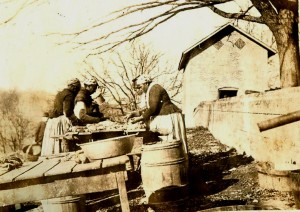
Slave Women Processing Pork on Wessyngton Plantation
Enslaved African American women performed various task on southern plantations and farms. Women on Wessyngton Plantation were not required to do any hard labor in the fields as the men did; however, they were an important part of other operations on the plantation. Women did light work in the gardens, they knitted and sewed for the slave community and their owners, worked the looms, and did the spinning and weaving. They were responsible for cooking, cleaning, washing, ironing, making cheese, preserves, and soap. No mother with a young baby was expected to do any outside work until her baby was two years old. There was a nursery on the plantation were children were cared for by elderly women too old to work. Women were a vital part of the pork processing industry on the plantation as seen in the photo above. Each week the women on the plantation would assemble at the plantation smokehouse (building in background of photo) and would be allotted bacon, meal, flour, sugar, and coffee based on the number of individuals in their families. Hundreds of hogs were killed at each year at Wessyngton to feed the enslaved population and the Washington family. Wessyngton had a reputation for producing its famous Washington Hams which could be found on the menus of the finest restaurants as far south as New Orleans and as far north as Philadelphia.
Tags:African American History, African American slavery, African American Women, Black Women during Slavery, Children in Slavery, Plantation Life, plantation slavery, Pork Production, Slave Labor, slave trade, Slave Women, Slave women in the south, Task System
Posted in Book Tour & Reviews, Civil War, Interviews, Plantation Life, Research | Comments Closed
Wednesday, October 7th, 2009
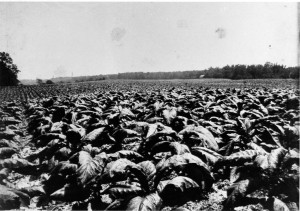
Wessyngton Tobacco Field
Slaves toiled endlessly, clearing land, plowing fields, raising livestock, erecting buildings, and planting crops to transform frontier landscapes into lavish plantations.
The enslaved population on Wessyngton Plantation primarily produced tobacco, which was very labor intensive. In 1860, 250,000 pounds of tobacco was produced on Wessyngton making it the largest producer of tobacco in the United States and the second largest in the world.
Tags:African American Plantation Life, African American slavery, black history, Civil War, plantation slavery, Plantation Slaves, Slave Labor, Slave Life, Slavery in America, Tennessee slavery, tobacco plantation, Tobacco Production
Posted in Civil War, Genealogy & DNA, Uncategorized | Comments Closed









